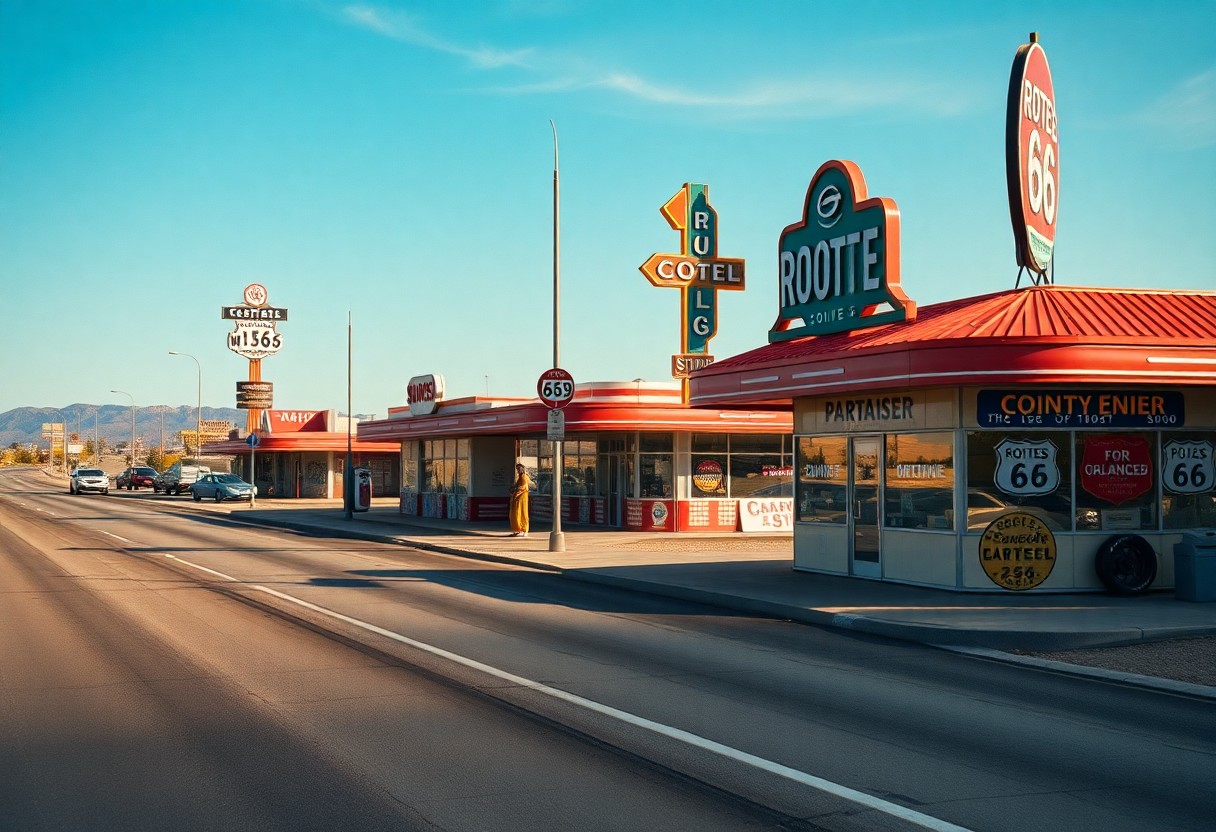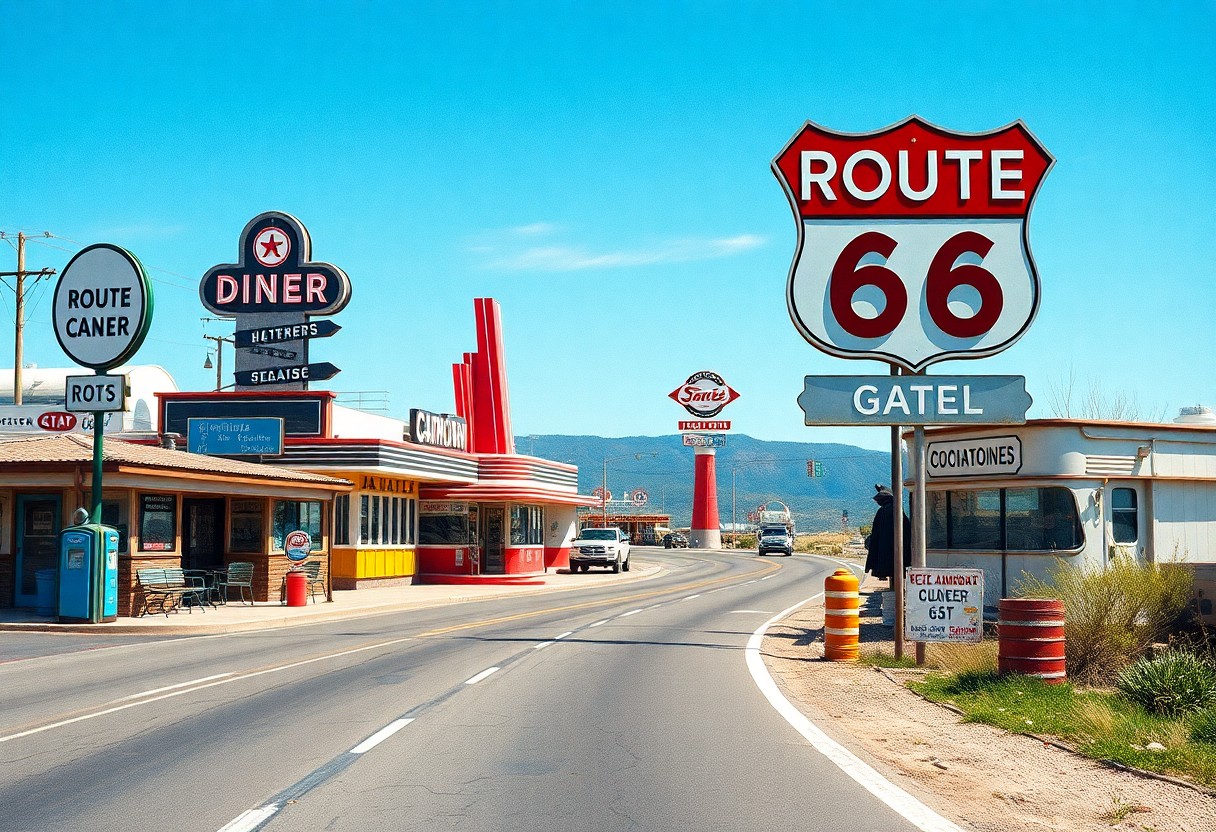Embark on an unforgettable adventure along the legendary Route 66, a 2,448-mile journey from Chicago to Los Angeles. This iconic highway opens the door to a world of discovery, offering an array of experiences that can range from a swift one-week highlights tour to a deep, immersive exploration over three weeks. As you traverse through eight states, you will encounter unique attractions, from the stunning Gateway Arch in St. Louis to the eccentric Cadillac Ranch in Texas. Your adventure culminates at the Santa Monica Pier, but the route is peppered with vintage diners, historic motels, and breathtaking landscapes, making it an essential bucket-list road trip for any travel enthusiast seeking to explore America’s heart and soul.

Crucial Insights for Your Epic Route 66 Journey
As you prepare for your Route 66 journey, it’s crucial to understand that this 2,448-mile historic highway connects Chicago and Los Angeles through a rich tapestry of eight states. Depending on your travel preferences, the journey can span anywhere from 8 to 21 days. This route features a fascinating mix of preserved original segments and modern alignments, providing a perfect balance between history and contemporary travel experiences that will captivate any road tripper eager to uncover the stories woven into this iconic highway.
Uncover the Deep Historical Significance of Route 66
The historical importance of Route 66 dates back to 1926 when it emerged as one of America’s first numbered highways. Your travels will follow a path that enabled millions of Americans to escape the Dust Bowl during the 1930s. The road earned the affectionate nickname “The Mother Road” from author John Steinbeck and became a beacon of hope during the Great Depression, bridging rural communities with opportunities in the West and shaping the American landscape in profound ways. Along this route, you will walk in the footsteps of countless adventurers who sought a better life.
Immerse Yourself in the Unique Charm of Route 66 Today
Today’s Route 66 exudes a unique charm, with 85% of the original road still drivable. You can uncover well-preserved sections that feature vintage motels, classic diners, and iconic roadside attractions, each adding to the rich narrative of American culture. This route now serves as a living museum of Americana, offering a genuine glimpse into mid-20th century life and inviting you to immerse yourself in the stories that shaped the nation. Every year, Route 66 attracts over 500,000 visitors from across the globe, eager to experience its historical and cultural significance firsthand.
Along the way, you’ll encounter numerous preservation projects dedicated to maintaining historic buildings and landmarks. The route also provides access to major national parks and monuments, including the breathtaking Grand Canyon and the stunning Petrified Forest, transforming your journey into an exploration of America’s stunning natural beauty and diverse landscapes that are truly awe-inspiring.
Optimize Your Trip: Planning the Ideal Route 66 Duration
To fully appreciate the beauty and history embedded in Route 66’s 2,448-mile stretch from Chicago to Los Angeles, you should allocate 2 to 4 weeks for your journey. The time you spend on the road will depend on your preferred travel pace, the number of stops you wish to make, and your exploration style. Whether you opt for a quick drive or a thorough adventure, you will have countless opportunities to experience the historic sites, local diners, and iconic landmarks that characterize this legendary route, making each moment a chance for unforgettable memories.
Identify the Key Factors That Influence Travel Time
Several factors can influence the duration of your Route 66 adventure, including your driving speed, the number of stops you choose to make, and weather conditions along the route. As you traverse through eight diverse states, each offering unique attractions and experiences, your daily mileage may vary anywhere from 150 to 500 miles based on your interests. By recognizing these variables, you can create a realistic schedule that aligns with your travel goals and expectations, ensuring a fulfilling experience without unnecessary stress.
Optimal Timeframes for Various Itinerary Styles
Your time requirements will vary according to your travel style: you can plan for 7-10 days for a quick highlights tour, 2 weeks for a balanced experience, or 3-4 weeks for an extensive exploration. Adjust your timetable to focus on specific regions or attractions that intrigue you the most. A practical strategy involves breaking your journey into manageable segments, allowing for shorter driving days in areas abundant with attractions, such as Oklahoma and Arizona. Additionally, consider including rest days in major cities like St. Louis or Albuquerque, and be mindful of seasonal weather patterns that could impact your travel speed and comfort during your road trip.
Effective Strategies for Smart Route Planning
Planning your Route 66 adventure requires setting clear goals and establishing time limits. A minimum of 2 weeks is recommended to explore key attractions without feeling rushed. Aim for daily driving distances under 200 miles to allow ample time for sightseeing and unexpected discoveries along your journey, ensuring each stop is a delightful experience.
Thorough State-by-State Exploration for a Memorable Journey
Your journey encompasses eight states, each offering unique experiences and attractions. Illinois kicks off your adventure in Chicago, Missouri showcases the iconic Gateway Arch, Oklahoma celebrates its rich western heritage, and California concludes your trip at the Santa Monica Pier, marking the end of your memorable journey filled with diverse cultural experiences and breathtaking sights.
Essential Navigation Tips for an Effortless Journey
To ensure a seamless travel experience, consider these essential tips:
- Keep offline maps handy for areas with limited cell service
- Download GPS coordinates for historic segments to guide your route
- Pack a physical Route 66 guidebook for reference
- Check road conditions daily to avoid surprises
Remember, cell service may be unreliable in more remote locations, so having these resources can make a significant difference in your travels.
Route 66 demands careful planning to prevent getting lost on older segments. Here are some additional strategies:
- Mark gas stations every 100 miles to maintain fuel
- Note locations of emergency services along your route
- Prepare alternate routes for potential detours
- List 24-hour facilities for emergencies during your trip
Be aware that some historical sections may be unpaved or temporarily closed for maintenance, so staying informed can help you plan accordingly.

Explore Unmissable Attractions Along Route 66
Enhance your Route 66 adventure by exploring these must-see attractions that represent America’s vibrant heritage. From historic landmarks to quirky roadside stops, each site contributes its unique flavor to your journey. You’ll encounter well-preserved sections of the original highway and contemporary interpretive centers that narrate the storied past of the Mother Road, making your trip not just a drive but a deep dive into America’s cultural fabric.
Discover Breathtaking Natural Landmarks Worth Visiting
Early travelers on Route 66 were often unaware that they were passing by some of America’s most breathtaking natural wonders. Today, you can visit the majestic Grand Canyon, the vibrant Painted Desert, and the enigmatic Meramec Caverns. These stunning natural attractions provide perfect opportunities for hiking, photography, and connecting with nature during your journey, allowing you to appreciate the incredible diversity of landscapes that define the American West.
Step Back in Time at Historical Sites Along Your Journey
If you have an interest in American history, Route 66 offers countless chances to immerse yourself in the past. From the Chain of Rocks Bridge in Missouri to the Painted Desert Trading Post in Arizona, you’ll discover preserved architecture and museums that recount the tales of the road’s golden age. Many historical sites along Route 66 have been meticulously restored to reflect their original grandeur, providing a tangible connection to the history that shaped America.
You can visit the Coleman Theater in Miami, Oklahoma, explore the Painted Desert Trading Post, or stop at the numerous preserved gas stations that line the route, each holding a piece of history and inviting you to reflect on the journeys of those who traveled before you.
Delight in Unique Roadside Attractions That Capture Your Imagination
Quirky pieces of Americana await you at every turn. The Cadillac Ranch in Texas, the Blue Whale of Catoosa in Oklahoma, and a plethora of neon signs create unforgettable photo opportunities and memorable stops along your journey. These iconic roadside attractions have become symbols of Route 66, each telling its own story and inviting you to engage with the whimsical spirit of the road.
Unique stops like the Giant Rocking Chair in Fanning, Missouri, or the enormous Blue Whale in Catoosa, Oklahoma, provide perfect chances for memorable snapshots and interesting stories to share with fellow travelers, making your trip a collection of experiences that resonate long after you return home.

Your Comprehensive Trip Preparation Guide for Route 66
To ensure a successful Route 66 adventure, proper planning is essential. Allocate 2-4 weeks for the full 2,448-mile journey based on your pace and planned stops. Booking accommodations and car rentals in advance can save you money and guarantee availability, especially during peak travel seasons. Your preparation should involve mapping out daily driving distances, pinpointing key attractions, and researching local events occurring along your route, creating a well-rounded experience.
Select the Best Times to Travel Route 66 for Optimal Enjoyment
If you’re hoping to experience the best weather conditions, plan your Route 66 trip for spring (March to May) or fall (September to November). These seasons typically offer mild temperatures and fewer crowds at attractions. Avoid the summer months (June-August), when temperatures can soar above 100°F in desert regions and tourist spots become overcrowded, detracting from the joy of exploration. Winter travel can come with unique challenges, including potential snow and ice in the Midwest sections, making careful planning essential.
Check Off Your Essential Packing List for a Smooth Journey
As you prepare to hit the Mother Road, your essential packing kit should include a reliable GPS device, paper maps as a backup, a well-maintained vehicle, and an emergency roadside kit. Don’t forget to bring a good camera for capturing memories, comfortable driving attire, and ample water to stay hydrated. It’s crucial to pack your valid driver’s license, vehicle insurance, and emergency contact numbers for peace of mind during your travels.
Additionally, consider these extra items: a first-aid kit stocked with basic medications, a portable phone charger, a flashlight with extra batteries, basic tools for minor repairs, and a stash of snacks for the road. A cooler for drinks can be useful, and ensure you have weather-appropriate gear for varying conditions. Keep your packing light but practical, as you’ll be making frequent stops and managing luggage regularly. It’s wise to have jumper cables and a spare tire in good condition in your vehicle’s trunk to handle unexpected situations.
Smart Budgeting Strategies for Your Route 66 Adventure
Exploring Route 66 doesn’t have to break the bank. Daily expenses can range from $100 to $300, depending on your choices and preferences. For a two-week journey, you should anticipate spending between $2,000 to $4,000 for two travelers, covering accommodation, food, fuel, and activities, allowing you to experience the best of what this iconic route has to offer.</
Categories:
Tags:


Comments are closed